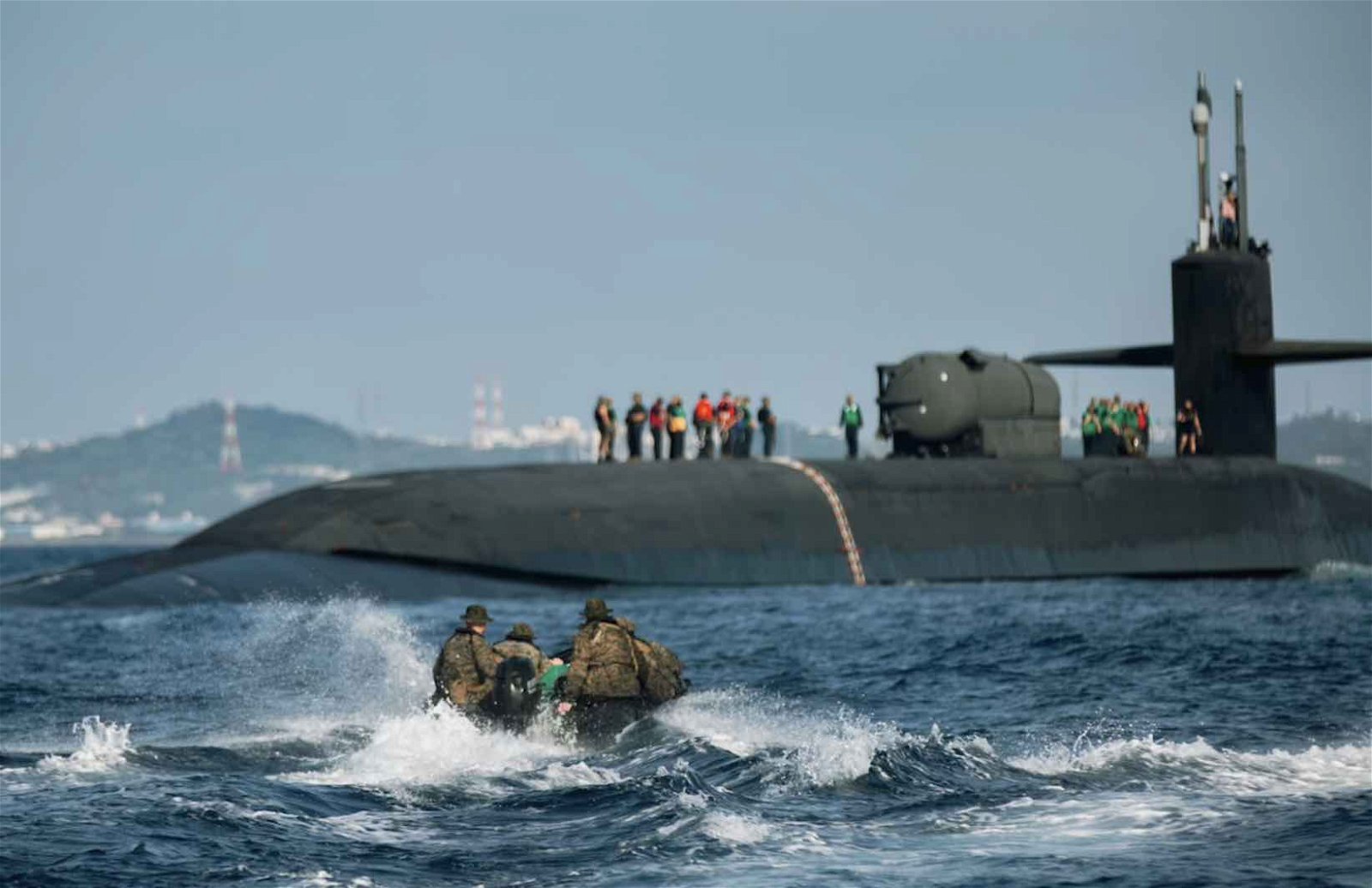

Welcome to this week’s installment of The Intelligence Brief… as the end of 2023 approaches, this week we’ll be looking at one of the areas that the U.S. Department of Defense currently cites as one of its greatest challenges. In our analysis, we’ll be looking at 1) what has had the DoD concerned in 2023, 2) how the U.S. has worked to advance its posture in the Indo-Pacific, and 3) what an advance look at a draft copy of a recent strategy assessment says about the U.S. and its inability to build weapons as quickly as our adversaries.
Quote of the Week
“We envision an Indo-Pacific that is open, connected, prosperous, resilient, and secure—and we are ready to work together with each of you to achieve it.”
– President Joe Biden, East Asia Summit, 10/27/21
Latest News: In recent coverage from The Debrief, experiments funded by NASA are showing that sending a probe to Enceladus to search for extraterrestrial life is viable. Elsewhere, a rare transient luminous event was captured in imagery obtained during a recent experiment aboard the International Space Station (ISS). Also, we are excited to announce our brand new Letters to the Editor section at The Debrief, where this week, bestselling author Whitley Strieber writes that we need more than just government officials, scientists, and academics involved in the UAP dialogue. You’ll find links to all our recent stories and other items at the end of this newsletter.
Podcasts: In podcasts from The Debrief, this week on The Debrief Weekly Report, MJ Banias and Stephanie Gerk dive into the Devil’s Church cave in Finland, what may have killed the dinosaurs, and a new fusion reactor in Japan. Elsewhere, on The Micah Hanks Program, I take my listeners on a deep dive into one of the most important military UAP cases of all time. You can get all of The Debrief’s podcasts by heading over to our Podcasts Page.
Video News: This week on Rebelliously Curious, Chrissy Newton is joined by Sarah Porter, the head of the Kyl Center for Water Policy at Arizona State University, who examines the advantages and disadvantages of plans to combat water shortages in the Southwest. Also, be sure to check out the latest episode of Ask Dr. Chance, and all the other great content from The Debrief on our official YouTube Channel.
Now, it’s time to look at some of the challenges 2023 brought with it and what the Pentagon says has managed to hold its attention the most amidst a year filled with global tensions.
In a Year of Challenges, Here’s What Has the DoD Concerned in 2023
2023 has been a year of many firsts, as well as major challenges. Recognized by scientists as the hottest summer on record in the Northern Hemisphere, it was also a year of major developments in fields of science and technology, with notable advances occurring in the burgeoning field of artificial intelligence.
This year has also been a year of financial upheaval, with a crisis that first erupted back in the spring with the failure of Silicon Valley Bank in March, leading to what experts have called the second-largest banking crisis in U.S. history, followed by a similar upset involving the San Francisco-based First Republic Bank just weeks later.
However, 2023 has also been a game-changer for the Department of Defense, and in particular, our country’s military posture in the Indo-Pacific, where developments over the last several months have led to the characterization of 2023 by military leaders as having been “the most transformative year for U.S. force posture” in the region.


The Indo-Pacific Remains a Challenge in a Year Rife with Turmoil
The U.S. has remained focused on its Indo-Pacific defense strategy, “Even with Russia’s invasion of Ukraine, the Hamas attack on Israel, terror attacks in the Red Sea and more,” according to assistant defense secretary for Indo-Pacific security affairs Ely Ratner, who spoke on the issue earlier this week.
The Department of Defense also said on Tuesday that the U.S. has made “steady and impressive progress” in the Indo-Pacific throughout the year, with concentrations among Pentagon leadership having remained focused on China.
Ratner, speaking with the Defense Writer’s Group, said that China “has been identified as the only country in the world with both the will and, increasingly, the capability to reshape the international order,” Ratner said. “That was the assessment at the time of the release of the National Defense Strategy, and that remains the assessment today.”
Ratner further characterized China and its ambitions as “the national security challenge of our time,” though emphasizing the historic work of Defense Secretary Lloyd Austin since February, where the secretary traveled to the countries of key strategic allies in the region.


“Within a 50-day period the secretary met face-to-face with all five of our treaty allies in the Indo-Pacific region, Thailand, the Philippines, Australia, Japan and South Korea,” Ratner said.
“These are remarkable engagements with our allies during a time [when] there are other things going on in the world.”
China is Outpacing the U.S. Arms Industry
Despite the U.S. working to strengthen its posture in the Indo-Pacific, there are still significant challenges within the quickly changing geopolitical landscape observed over the last twelve months.
Last week, citing a draft copy of the new National Defense Industrial Strategy, Politico reported that the U.S. arms industry is currently unable to meet the demands of weapons development at the pace required per current global demands.
A draft version of the forthcoming report stated that the U.S. “does not possess the capacity, capability, responsiveness, or resilience required to satisfy the full range of military production needs at speed and scale,” Politico reported on December 2.
“This mismatch presents a growing strategic risk as the United States confronts the imperatives of supporting active combat operations,” the document reveals, “while deterring the larger and more technically advanced pacing threat looming in the Indo-Pacific.”
Despite the challenges—militarily and otherwise— that 2023 has presented, the Pentagon has continued to tout its successes, particularly in the Indo-Pacific. Ratner said this week that “through the investments we are making [the U.S. is] more capable in the region.”
“We’re more forward in the region due to the force-posture changes that we made,” Ratner added. Although the U.S. Department of Defense appears to feel confident about its progress amidst a quickly evolving global dynamic, it is one that, with the arrival of 2024, brings the promise of similar challenges, but also opportunities.
“We’re more together in terms of really remarkable progress,” Ratner said, “and deepening our cooperation with our allies and partners.”
That concludes this week’s installment of The Intelligence Brief. You can read past editions of The Intelligence Brief at our website, or if you found this installment online, don’t forget to subscribe and get future email editions from us here. Also, if you have a tip or other information you’d like to send along directly to me, you can email me at micah [@] thedebrief [dot] org, or Tweet at me @MicahHanks.


Here are the top stories we’re covering right now…
- NASA Funded Experiments Show Detecting Signs of Life in Water Ejected from Enceladus is Viable
Experiments funded by NASA show that sending a probe to Enceladus to search for extraterrestrial life is viable.
- Scientists Build a $70 Self-Powered Portable Light That Sanitizes Food
Scientists have developed the Tribo-sanitizer, a device that uses light to enhance food sanitization, and it only costs about $70.
- Left Abandoned in the Devil’s Church Cave This week on The Debrief Weekly Report…
On today’s episode, we dive into the Devil’s Church cave in Finland and seek out the science behind a weird phenomenon. We also get into what may have actually killed the dinosaurs, according to a new study, and we cover a new fusion reactor that just booted up in Japan.
- Rare Transient Luminous Event Captured in Imagery During International Space Station Experiment
A rare transient luminous event was captured in imagery obtained during a recent experiment aboard the International Space Station (ISS).
- 7000-Year-Old Perishable Artifacts Preserved by Ice Are Revealed in Ancient Volcanic Landscape
Archaeologists say an undiscovered trove of ancient artifacts has been revealed by the thawing of ice in northern British Columbia, Canada.
- James Webb Space Telescope Rediscovers Mysterious Vanishing Ghost Galaxy Astronomers Are Calling a “Monster”
The James Webb Space Telescope has relocated a ghostly dusty galaxy originally detected by ground telescopes before it mysteriously vanished.
- The World’s Largest, Most Advanced Experimental Fusion Reactor is Now Operational, Officials Announce
The largest and most advanced fusion reactor of its kind has commenced operations in Japan in a new cooperative effort between nations in the development of fusion energy.
- China Unveils New Air-Launched Orbital Spacecraft in Its Latest Bid to Win the Space Race
China is making significant advancements in its space technology by developing a new reusable air-launched orbital rocket system.
- Quantum 2.0: Discovering the Next Generation of Quantum Technology
Quantum materials present an enticing vision of a cleaner, more sustainable future. Innovative research is showing how they can be developed.
- It’s Time to Think Beyond the Science and National Security Framework When It Comes to Unidentified Anomalous Phenomena
Now is the time for us to begin taking a serious, multi-spectrum view of unidentified anomalous phenomena (UAP).
- 250-Mile-High View of Mars Catches Glimpse of a Mystery Lurking in Orbit Above the Red Planet (Images)
An uncommon view of the Martian horizon was recently obtained by NASA’s Odyssey orbiter, in new images that offer a glimpse at one of the most mysterious objects orbiting the Red Planet.
- The U.S. Air Force Office of Scientific Research is Aiming to Track and Identify Unresolved Resident Space Objects
The U.S. Air Force Office of Scientific Research is funding an effort to track and characterize unresolved resident space objects.
- The Battle for UAP Disclosure in Washington
This week, we examine the battle that rages on in Washington over whether legislation that could help to ensure UAP disclosure will pass into law.
- The Fight for UFO Transparency
There’s trouble brewing on Capitol Hill, as a group of top lawmakers are banding together to attempt to block the UAP Disclosure Act of 2023.
- NASA Readying Radioisotope-Powered Spacecraft Fueled by Plutonium-238 to Explore the Deepest Reaches of Space
Following the receipt of plutonium-238 from the DOE, NASA says they are planning deep space missions powered by radioisotope generators.
- Not Just a Meteor: New Study Reveals Another Culprit in the Mass Extinction of Dinosaurs
New study reveals volcanic eruptions and climate change played a role alongside the famed asteroid impact in the dinosaurs’ extinction.
- Breakthrough in Quantum Storage of Entangled Photons May Usher Age of Solid State-based Quantum Networks
Scientists report a breakthrough in the quantum storage of entangled photons at telecom wavelengths within a crystal, new research shows.
- AI Can Read Cuneiform Now This week on The Debrief Weekly Report…
On today’s episode, we discuss an ancient discovery into human wearable technology, how AI is now being used to decipher ancient cuneiform tablets, and why NASA wants to grow food in lunar soil.
